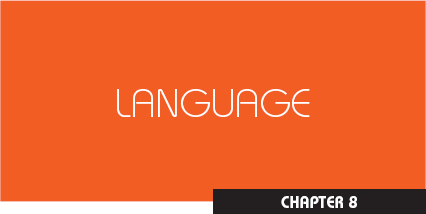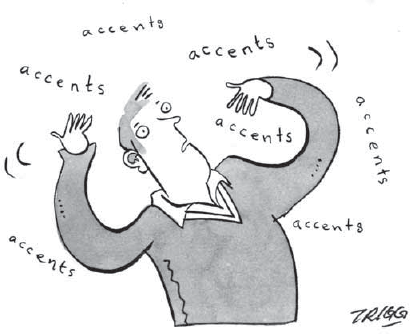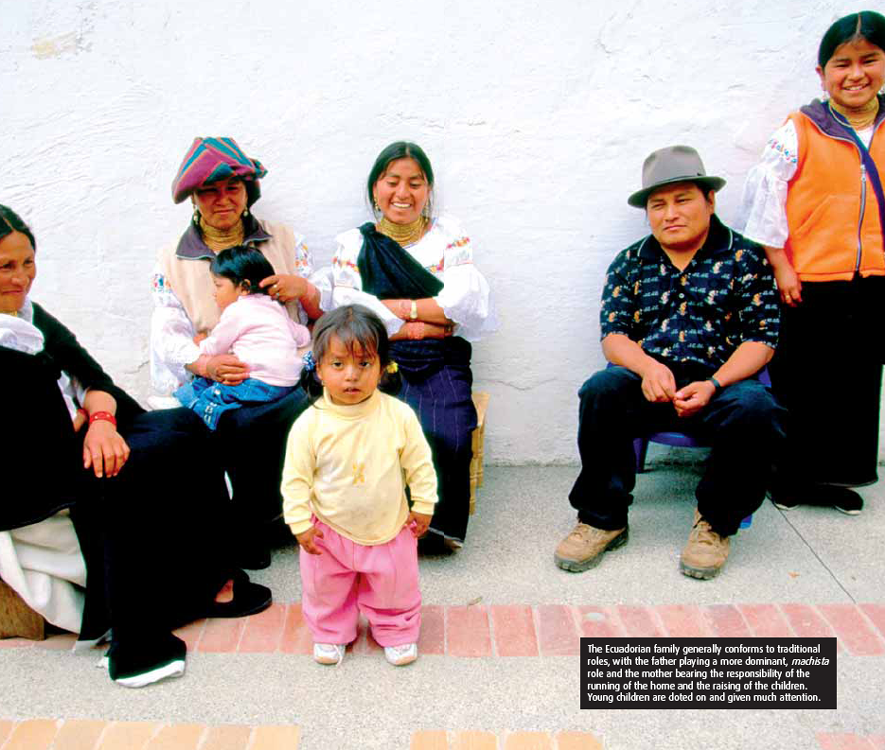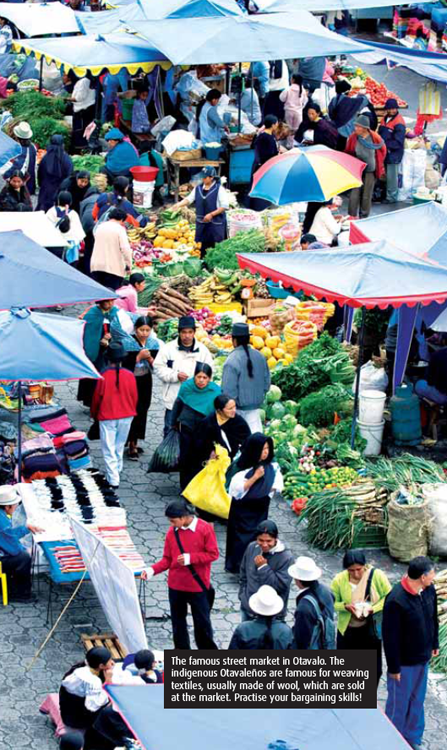

‘Class distinction pervades the language as well.’
—Albert B Franklin, Ecuador: Portrait of a People
IN ECUADOR, THERE ARE ABOUT 12 MILLION Spanish-speakers; about 3 million speakers of American Indian languages; 65,000 English-speakers; 32,000 German-speakers; 11,000 Bokmål- or Dano–Norwegian-speakers; 7,000 Chinese-speakers; and 1,800 Arabic-speakers. If you’re going to live in or visit Ecuador, Spanish is the most useful language to master, although American Indian languages (especially Quichua) may be the first language of many indigenous people.
Spanish is the official language, spoken by about 90 per cent of the population. If you’re looking for a school to study Spanish, good news, Ecuador is one of the most popular destinations in Latin America for estudiantes del idioma español (students of the Spanish language).
The form of Spanish used here is more accurately referred to as castellano (Castilian), the basis of modern standard español (Spanish). Castilian was commonly spoken in northern and central Spain and became the official language in the 15th century. It came to be spoken in southern and western Spain but with a different accent. (The most obvious difference between northern and central Castilian and southern and western Castilian can be heard in the pronunciation of the letter c. In the northern and central region, it is pronounced as an English ‘th’; and in the southern and western regions as an English ‘s’.) It was the southern and western form of castellano that became the standard in Latin American Spanish.
There are three distinct Spanish accents or intonations in Ecuador originating from the Costa, the Sierra and the Oriente regions. After some time here, you will be able to distinguish which part of the country the speaker comes from. Look out also for the regional differences in pronunciation and words. One of the most interesting accents in Ecuador is from the inhabitants of Cuenca. They have a very graceful lilting quality to their speech, as if they are singing when they speak. Ecuadorians outside of Cuenca often describe the Cuencanos language in this way: When one Cuencano is speaking you have a solo, when there are two Cuencanos speaking you have a duo, and when three Cuencanos are speaking you have a trio. However, if there are more than three Cuencanos speaking you have a choir.
Along the coastal region you will find that most inhabitants will drop the s, y and z off the end of a word. This can cause havoc for a nonnative speaker. For example, if one is to say los libros, los pollos or los zapatos, the listener will hear lo libro, lo pollo and lo zapato. The nonnative speaker will wonder why the s has been dropped off plural nouns. An example of the z being dropped in coastal speech is with the word lápiz (pencil) and maíz (maize), pronounced as lapi and mai.

Many linguists believe that the Spanish spoken in Quito and Loja is the purest form of Spanish spoken in Ecuador. There is a slight difference in the cadence of Spanish spoken in the Sierra as opposed to the Costa or Oriente regions. There is a small stress on the third syllable from the end of the word. When Serranos speak, it almost sounds like music and some people have compared their pronunciation to birds singing. However, many Serranos find this comment derogatory. The Serranos enjoy pronouncing their r letters. So much so that the Costeños like to do the same, calling them Serranos! The Serrano would pronounce carro (car) as carro whereas the Costeño would say caro. The regional accents really come into play with words like caballo (horse), which sounds like cabasho in the Sierra but cabayo on the coast. Have fun learning to distinguish between the regional accents!
As in any culture, slang terms develop that often replace standard language. Proper use of slang will help you break the ice more quickly with the locals. Slang or colloquialisms in any culture often distinguish the outsiders from the insiders of the culture and are considered informal in nature. However, many Ecuadorians will judge the social class they consider you to be in purely by your use of slang.
I remember the first time I used the slang word pana (good friend). The local I was speaking to was pleasantly surprised. It is important, however, to remember that slang takes time, study and experience to use properly. When I used the same word on a second occasion, the female Ecuadorian I was addressing was not impressed. She explained to me that she understood the term as being used with someone you wanted to smoke marijuana with. I quickly informed her that I had no intention of doing that, and learnt later that this term had different meanings when used with different classes. Use of slang will often tell others what social rank you maintain.
Higher social class Ecuadorians believe slang is primarily used by the lower classes. When I used the word pluto to announce that I was drunk, a local friend haughtily replied that she didn’t belong to the lower classes and not to use that term around her. (I have included some common middle and lower class slang words in the Glossary at the back of the book.)
However, there are numerous slang words which are used by every stratum of society. I was once in a cab several years ago when it ran over a speed bump very roughly. The driver exclaimed “¡Odio el vigilante acostado!” (Literally translated “I hate the traffic officer that is lying down!”) I turned around thinking he had run over a traffic cop until I realised that, in Ecuador, a speed bump is referred to as a traffic officer lying down. (In the Sierra, the word for ‘vigilante’ is chapa.) Slang vocabulary should, in most cases, not be used during formal situations, job interviews or presentations.





In Ecuador, another aspect of Spanish is its use of ‘niceties’. Ecuadorians are generally more courteous or formal in their language than the Americans. They try not to give commands but make requests to everyone from superiors to cabdrivers. This is especially true between employees and employers. For example, it is very rare for employees to call their boss by their first name.
Diplomacy is a common characteristic in much of the language used. A person might say “No, usted no me ha comprendido.” (“No, you don’t understand me.”) But the more appropriate and polite way to say this is “Me he explicado mal—voy a expresarme mejor.” (“I explained it poorly—I am going to express myself better.”) Notice the attempt to avoid conflict. This is an important cultural custom in Ecuador.
Speak Elegantly
Ecuadorian writer Rómulo Vinueza explains that one should speak with ‘elegance’ and ‘sincerity’. Another example of this is the various ways to express thanks. While saying gracias conveys thanks, the following phrases express the same emotion more genuinely and sincerely. In fact, after receiving a compliment it is considered rude by some to answer with a mere gracias!
Useful phrases include:
 “¡Le quedo muy agradecido!”—“I am very grateful!”
“¡Le quedo muy agradecido!”—“I am very grateful!”
 “¡No sé como agradercerle!”—“I don’t know how to thank you!”
“¡No sé como agradercerle!”—“I don’t know how to thank you!”
 “¡Muy agradecido!”—“I am very grateful!”
“¡Muy agradecido!”—“I am very grateful!”
An Ecuadorian’s first name is usually followed by his or her father’s last name and the mother’s maiden name. Juan García Lopez’s father’s last name is García and his mother’s maiden name is Lopez. In the phonebook, you would look up Juan’s name under García Lopez, Juan. In most cases, you would use the first last name, except at formal occasions, in writing or for legal purposes, i.e. Juan García Lopez would more often be referred to as Juan García.
The use of the last name with a married woman can also be confusing for an English speaker. If Julia Batista Guzman marries Juan García Lopez, she may be referred to in several ways. The one form she is never referred to is Señora Juan García, thus using her husband’s last name. In a formal situation, de (which means ‘of’) is inflected after her husband’s last name, i.e. Julia Batista de García. In many cases, she will still be referred to as Julia Batista or Julia Batista Guzman. When her husband introduces her he will say “May I introduce my wife, Julia Batista Lopez, to you”. When referring to her, you may say “La Señora Julia Batista,” still using her father’s last name. Addressing her directly, you would say “Señora Batista (father’s last name)” or “Señora García (husband’s last name)”.
Another confusion for foreigners is how to address a woman—Señorita (Miss) or Señora (Mrs)? There is no ‘Ms’ title in Ecuador. The simple rule I use is if the woman is relatively young, address her as Señorita. She will correct you if she is married and respond by saying “Señora”. If she appears middle-aged or older it is relatively safe to address her as Señora.
The most common professional titles in Ecuador are: Doctor/Doctora (male and female titles for Doctor), Ingeniero/Ingeniera (male and female titles for Engineer) and Licenciado/Licenciada (referring to a male or female who is a specialist or is qualified in a particular field, often a lawyer). The last name is usually used with the title, e.g. Licenciada Lopez or Ingeniero Guzman. It is just as common to address Ingeniero Guzman as Ingeniero, even in a room full of other Ingenieros!
You will soon discover in Ecuador that most people have a nickname of sorts among good friends or family. Nicknames or apodos are a very strong part of Ecuadorian culture. You will most probably be given one too.
I know someone who was a little chubby when she was young and was nicknamed Pocha (meaning short and pudgy). Nearing 50 years old, fit and slim, she’s still called Pocha by her family and friends. She even introduces herself as Pocha.
Many of the nicknames in the Sierra use Quichua combined with Spanish. There are literally hundreds of nicknames, such as Huevito (little egg), Carepavo (turkey face) and Pelusa (referring to someone with fine hair). The Manta area nicknames are also used for people from different regions of Ecuador. Care should be used if you’re going to use regional apodos as they are often perceived as derogatory. These should only be used if you’re a close friend. Here are some examples: Guaitambos from Ambato, Morlacos from Cuenca, Morenos or Negros from Esmeraldas, Monos from Guayaquil, Puendos from Imbabura, Mashcas from Latacunga/Cotopaxi, Pata Amarilla from Manabí, Cara de Papa (meaning potato face), Longo and Pachuco from Quito.

Given names have a unique Ecuadorian twist to them in the Manta and the Manabi province. Mothers and fathers in this area often name a child after a product or event surrounding conception or birth. Such given names include Alka-Seltzer, gasoline and aspirina. You will also find along the coast many blacks with the given name of a former US president such as Washington or Jefferson.
What is the correct way to address an individual? In English, there is only one word: ‘you’. Spanish has two forms: tú or usted. Tú is considered the familiar form and usted, the formal.
Tú is primarily used with very close friends and family, although children may use usted with a parent. To be on the safe side, I always use usted if there is any ambiguity. This is the correct form with strangers or in business. If someone wishes you to refer to him or her with the tú form, they will let you know. Tú can also be used by someone wishing to put you down, indicating that the speaker is of a higher social standing.
It is believed that at the time of the Spanish conquest, some 30 indigenous languages were spoken in Ecuador. Today, only about 12 indigenous languages exist in the lowlands (of which nine are used in the Oriente: Siona; Secoya; Tetete; Cofán; Huaorani; the Jívaroan languages Shuaran and Achua; Quichua; and Zapora). Only three indigenous languages (Colorado, Cayapa, and Coaiquer) are still spoken in the western coastal lowlands, with a total of about 48,000 speakers. The only indigenous language left in the Sierra is the northern dialect of the Quichuan language family (known as high-land Quichua or chinchay), with about 3.5 million speakers.
The decline of many indigenous languages and the increasing bilingualism with Spanish is a product of the locals’ increasing contact with whites and mestizos. The domination and exploitation of indigenous communities by whites and mestizos in the quest for ‘progress’ has posed a threat to the land, and to the people and cultures who originally inhabited it.
The Quichua refer to themselves as runa (the people). The Quichuan languages were the languages of the former Inca Empire (Tawantinsuyu). There are at least 20 dialects of Quichua in Ecuador. Quichua in Peru is written Quechua.
Some Quechuan words have entered the English language: cuca (cocoa), huanu (guano), huanaco, huanacu (guanaco), pampa (pampa), puma (puma), quipu (quipu) and kinua, kinoa (quinoa). The most difficult sound for English-speakers is the Quechuan q, which sounds like the German ‘ch’ in Bach, except it is pronounced even further back in the throat. Quichua can be heard in Andean music, which is getting easier to find in the United States, either in its purer form, used by groups such as Markahuasi, Ayllu Sulca and Ch’uwa Yacu, or its more Westernised forms, used by the group Inti-Illimani. The Peruvian singer Yma Sumac has the Quichuan name ima sumaq, which means ‘how beautiful!’.
Quichua has been heavily influenced by Spanish. Some 30 per cent of the lexicon, even with monolingual speakers, comes from Spanish. Examples include riru (from Spanish dedo meaning ‘finger’), arwi (from Spanish adobe meaning ‘sun-dried brick’ or ‘seasoned’), chufir (from Spanish chofer meaning ‘chauffeur’) and sirbisa (from Spanish cerveza meaning ‘ale’ or ‘beer’). Some Quichuan words have also passed into Latin American Spanish:
|
potato |
|
|
|
corncob |
|
|
|
jacket |
|
|
|
shirt |
|
|
|
maid or worker |
|
|
|
guinea pig |
|
|
|
earth oven |
|
|
|
flute |
|
|
|
cop |
|
|
|
farm |
(There are over 100 Quichuan basic vocabulary words in the Glossary section at the back of this book.)
Quichua has become increasingly popular in US university programmes over the last five to ten years. It is a langauge now spoken by 11 million people in five countries straddling the Andes, from Colombia to Argentina.
One of the best programmes for Quichua is the Amazon and Andes Field School, open to university students and educators. Operated by Arizona State University, it runs a winter and summer programme which are offered on the banks of the Napo River, giving the student full immersion into the Quichua culture. Language programmes in Waorani and Shuar are also offered. For more information visit:
Spanish schools are a very important source of income for Ecuador. Walking along Avenida Amazonas in Quito, you will find no shortage to choose from. But you will also find varying degrees of quality. The competition is so fierce that I have even seen language classes offered for as little as US$ 3 per hour. Most schools offer live-in arrangements with Ecuadorian families which will, no doubt, help you improve your Spanish.
School Tips
I believe that references are a very good indicator of what a good programme is. Another option for finding a programme is a broker or agent located in the United States representing the school. These are usually paid a commission and may represent several schools. Three such services based in the United States are Language Link (http://www.langlink.com), Spanish Abroad (http://www.Spanishabroad.com) and AmeriSpan (http://www.amerispan.com). These firms have been around for some time and have good reputations.
Additonal recommendations are:
 Academia De Español Quito
Academia De Español Quito
Website: http://regio.com/ecuador/learnsp1.html
 Academia De Español ‘Surpacifico’
Academia De Español ‘Surpacifico’
Website: http://www.surpacifico.k12.ec
 Academia Latínoamericana de Español
Academia Latínoamericana de Español
Website: http://www.ecuador-Peru-bolivia.com
 Activa Spanish School
Activa Spanish School
Website: http://www.activa-spanish.com
 Andean Study Programs
Andean Study Programs
Website: http://www.andeanstudy.com
 Apuinty Spanish School
Apuinty Spanish School
Website: http://www.apuintyspanishschool.com
 Bipo and Toni’s Academia de Español
Bipo and Toni’s Academia de Español
Website: http://www.bipo.net
 Centro de Español Vida Verde
Centro de Español Vida Verde
Website: http://www.vidaverde.com
 Escuela de Español Simón Bolívar or Simón Bolívar Spanish School
Escuela de Español Simón Bolívar or Simón Bolívar Spanish School
Website: http://www.simon-bolivar.com
 Galápagos Spanish School
Galápagos Spanish School
Website: http://www.galapagos.edu.ec
 Instituto Superior de Español
Instituto Superior de Español
Website: http://www.instituto-superior.net
 Mitad Del Mundo
Mitad Del Mundo
Website: http://www.ecua.net.ec/mitadmundo
 Ordex Cultural Programs
Ordex Cultural Programs
Website: http://www.ordex.org/pages/language_culture_programs.htm
Website: http://www.otavalospanish.com
 Quito Spanish Institute
Quito Spanish Institute
Website: http://www.quitospanish.com